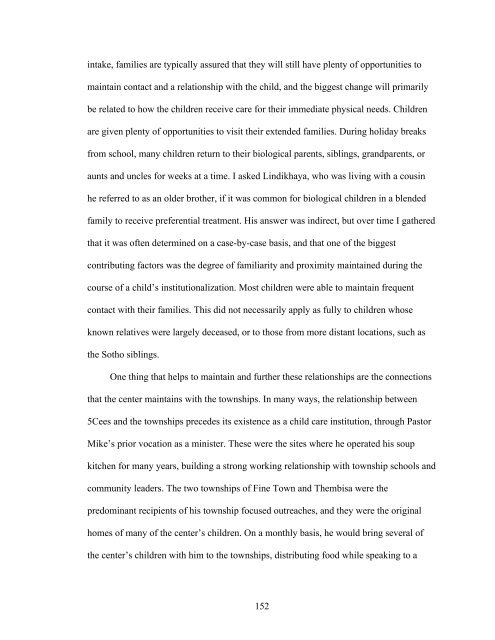INSTITUTIONALIZED CHILD CARE IN URBAN SOUTH AFRICA
You also want an ePaper? Increase the reach of your titles
YUMPU automatically turns print PDFs into web optimized ePapers that Google loves.
intake, families are typically assured that they will still have plenty of opportunities to<br />
maintain contact and a relationship with the child, and the biggest change will primarily<br />
be related to how the children receive care for their immediate physical needs. Children<br />
are given plenty of opportunities to visit their extended families. During holiday breaks<br />
from school, many children return to their biological parents, siblings, grandparents, or<br />
aunts and uncles for weeks at a time. I asked Lindikhaya, who was living with a cousin<br />
he referred to as an older brother, if it was common for biological children in a blended<br />
family to receive preferential treatment. His answer was indirect, but over time I gathered<br />
that it was often determined on a case-by-case basis, and that one of the biggest<br />
contributing factors was the degree of familiarity and proximity maintained during the<br />
course of a child’s institutionalization. Most children were able to maintain frequent<br />
contact with their families. This did not necessarily apply as fully to children whose<br />
known relatives were largely deceased, or to those from more distant locations, such as<br />
the Sotho siblings.<br />
One thing that helps to maintain and further these relationships are the connections<br />
that the center maintains with the townships. In many ways, the relationship between<br />
5Cees and the townships precedes its existence as a child care institution, through Pastor<br />
Mike’s prior vocation as a minister. These were the sites where he operated his soup<br />
kitchen for many years, building a strong working relationship with township schools and<br />
community leaders. The two townships of Fine Town and Thembisa were the<br />
predominant recipients of his township focused outreaches, and they were the original<br />
homes of many of the center’s children. On a monthly basis, he would bring several of<br />
the center’s children with him to the townships, distributing food while speaking to a<br />
152


